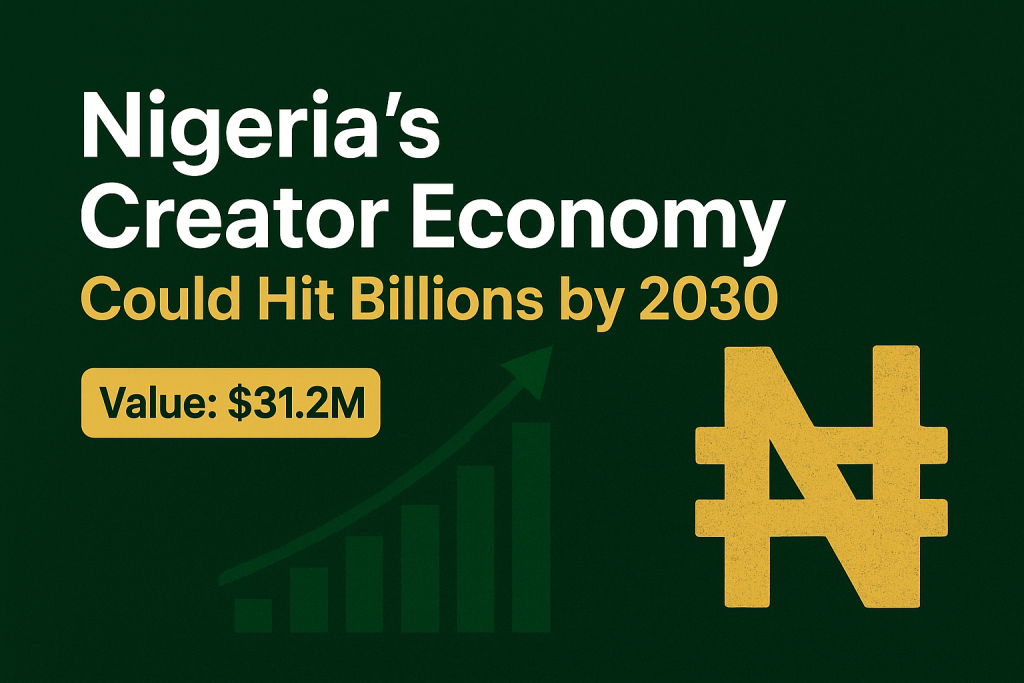Nigeria’s creator economy, valued at $31.2 million in 2025, is projected to grow into a multibillion-dollar industry by 2030, according to the Nigeria Creator Economy Report (NCER) 2025, developed in collaboration with the Federal Ministry of Art, Culture, Tourism, and the Creative Economy (FMACTCE), the National Council for Arts and Culture (NCAC), TM Global, and Communiqué.
This report offers one of the clearest looks yet at how creators, digital platforms, and government policy are reshaping Africa’s largest cultural hub.
A Creative Industry Already Driving Economic Impact
The NCER highlights how creative industries are reshaping Nigeria’s economy:
- In 2024, the music industry paid Nigerian artists ₦58 billion ($38.67 million) in royalties (NCER 2025).
- The fashion sector expanded into a $4.7 billion industry, proving Nigeria’s style economy is a powerhouse (NCER 2025).
- Spotify distributed royalties worth ₦58 billion ($38.67 million) from more than 30 billion Afrobeats streams globally.
- YouTube AdSense paid Nigerian creators $10 million in 2024.
- Instagram remains the largest income driver for local creators, accounting for 45% of reported earnings, while TikTok hosts 6.3 million Nigerian creators, expanding access and visibility (NCER 2025).
Still, income inequality persists: 56% of creators earn below $100 monthly, while only 3% earn more than $5,000, the NCER reveals. Despite this, Nigerian talent continues to command global attention—such as Don Jazzy’s $200 million Mavin Records deal with Universal Music Group, Funke Akindele’s ₦4.7 billion ($3.13 million) box office record, and Mark Angel Comedy’s YouTube subscriber milestones.
Why Policy and Data Matter
“The report captures the energy of a generation whose content defines culture, shapes perception, and creates wealth,” said Obi Asika, Director-General of the NCAC.
Minister Hanatu Musa Musawa (FMACTCE) reinforced this point by stressing the importance of reliable data, citing the D30 Data Platform, launched as an open-source hub for cultural and creative insights. “Without data, progress cannot be measured, challenges cannot be mapped, and opportunities cannot be scaled,” she said.
Four Forces Shaping the Next Five Years
The NCER identifies four key drivers that will shape Nigeria’s creator economy:
- Capital & Professionalisation → creators forming structured businesses and diversifying income.
- Policy Infrastructure → initiatives like the Creative Economy Development Fund (CEDF) and Creative Leap Acceleration Programme (CLAP).
- Talent Globalisation → Afrobeats, Nollywood, and Nigerian visual art continuing to dominate global culture.
- Tech & AI Integration → artificial intelligence reshaping workflows, IP protection, and monetisation.
According to David I. Adeleke, founder and CEO of Communiqué, “Our research reveals a nation at the crossroads of cultural dominance and economic revival. Nigeria’s creative talent has already captured the world’s attention.”
What It Means for Stakeholders
- For creators: The NCER urges adopting AI tools, scaling beyond passion into structured businesses, and forming alliances that cut costs and expand reach.
- For policymakers: Formalise the creative economy within national strategy, protect intellectual property, and invest in creative infrastructure.
- For investors: The report positions Nigeria’s creator economy as a frontier market with billion-dollar potential.
The Big Picture
With its current $31.2 million value and its projected multibillion-dollar potential, Nigeria’s creator economy is not a side story—it’s a cornerstone of Africa’s digital and cultural future. The next five years will be decisive: will talent, policy, and capital align to unlock this opportunity?
👉 For creators: adapt, innovate, and scale.
👉 For policymakers and investors: act now before the global wave moves past.
The world is already watching Nigeria, not just for Afrobeats and Nollywood, but as a rising force in the global creator economy.

